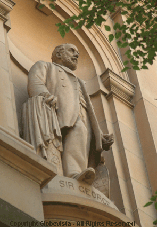Sir George Grey statue

Public Art: Sir George Grey statue
Sculptor: © Alexander Sherriff
Description: The sandstone carving of Sir George Grey, explorer and Governor of South Australia, is one of 23 sandstone carved figures on the ledges of the Lands Department Building.
Date Unveiled: c1891
Location: The statue of Sir George Grey is located in a niche on the Gresham Street facade of the Department of Lands Building, Bridge Street, Sydney, Australia.
So Who Was George Grey? Sir George Grey (14th April 1812 – 19th September 1898) was born in Lisbon, Portugal. His mother went into labor prematurely after overhearing that her husband had been killed at the battle of Badajoz. Grey was educated in Surrey, England and later admitted to the royal military college in 1826.
In 1837 Grey tried his hand at exploring without much success. His first expedition was to explore north-west Australia from Cape Town which ended badly when the party, which included Lieutenant Lushington, Mr. Walker (a surgeon and naturalist) and two corporals, landed in Hanover Bay and found themselves completely lost. It didn’t help that Grey got himself speared during a fight with Aborigines. After exploring part of Glenelg River, Grey discovered his wound had formed a nasty abscess, so the party decided to head back to Mauritius so he could recover.
Two years later Grey was back, this time returning to Western Australia where his boats were wrecked at Gantheaume Bay and they had to walk back to Perth, which was some walk. 483 km/300miles to be exact. Luckily for the expedition they had Kaiber, a Whadjuk Noongar (aboriginal) who helped them find food and water during their long journey. On a positive note he did get to learn the Noongar language.
From 1841-1845 Grey became the 3rd Governor of South Australia before heading to the land of the long white cloud to govern New Zealand. In this position Grey excelled, serving as Governor twice, from 1845 to 1853, and then again from 1861 to 1868. Grey was instrumental in resolving the bickering and fights between settlers and Māori over land claims. Grey blamed the disputes in the north on Henry Williams and other missionaries, regarding them as ‘no better than land-jobbers’ whose desire for land would require ‘a large expenditure of British blood and money’. The Māori grew to respect Grey as he assured them their land rights were safe under the terms of the Treaty of Waitangi.
Grey’s second term as Governor didn’t prove to be so successful. Grey was pretty much an honorary Māori by that time, often traveling with the chiefs and learning their language. He encouraged the Maori to write down their traditions, legends, and customs so they could be preserved. However in 1863, he launched the Invasion of Waikato to take control over the Māori agricultural region. This war brought many troops to New Zealand.
In 1868,after Grey refused instructions to organize the return of the regiments, he was recalled and replaced by Sir George Bowen.
This little hiccup didn’t deter his ambitions and in 1854 he became governor of Cape Colony (now South Africa). He was instrumental in setting land aside for the natives to protect them from the white colonists. He also strongly pushed for a federated South Africa but his proposals fell on deaf ears despite the willingness of other states. In 1859 he was again recalled back to England but a change in government on his arrival home resulted in him being given another term in South Africa. During his term, war with Maori broke out in New Zealand and he was again appointed Governor there. Busy man. The Maori Wars were a result of land fights between the Maori and colonists.
Prior to 1860 the Maori still owned most of the land of the North Island, but due to a large increase in the number of immigrants in the 1850s there was a strong demand for the government to purchase more land. Understandably many Maori were determined not to sell. However in 1859 Te Teira, a Maori of the Taranaki area, sold his Waitara River land, without the consent of his tribe, to the colonial government, sparking the first conflict of the Taranaki War of 1860-61.
The people of Cape Colony were so saddened at Grey’s departure they erected a statue at Cape Town in his honor. He was described as “a governor who by his high character as a Christian, a statesman, and a gentleman, had endeared himself to all classes of the community, and who by his zealous devotion to the best interests of South Africa and his able and just administration, has secured the approbation and gratitude of all Her Majesty’s subjects in this part of her dominions”
Grey died in London on 19 September 1898 and was buried in St Paul’s Cathedral.
Further information can be found in History of Australia.